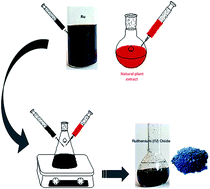Green biosynthesis of ruthenium oxide nanoparticles on nickel foam as electrode material for supercapacitor applications
Abstract
Ruthenium(IV) oxide (RuO2) nanoparticles were synthesized via Aspalathus linearis natural extract as a reducing/oxidizing agent, as well as a capping compound. RuO2 nanoparticles synthesised via a complete green chemistry process would be beneficial for the development of clean, nontoxic and environmentally friendly bio-synthesis procedures. The deposition of RuO2 nanoparticles on nickel foam (NiF) was carried out to form NiF/RuO2 electrode material. Structural characterization showed the amorphous nature of the biosynthesized RuO2, and demonstrated the characteristic peaks of Ni, while the XPS images exhibited the characteristic shape of the Ru 3d, 3p core level peaks, as well as O 1s of the deposited RuO2 on NiF. The electrochemical investigations of the NiF/RuO2 electrode showed a high specific capacitance of 750 F g−1 at a current density of 10 Ag−1 for our device measured by using a three-electrode configuration. The NiF/RuO2 electrode also demonstrated a high rate capability of ∼97.5% capacitance retention at a current density of 10 Ag−1. These results confirmed that the green biosynthesis of RuO2 on NiF could be a promising method to fabricate supercapacitor electrodes with high electrochemical performance for supercapacitor applications.


 Please wait while we load your content...
Please wait while we load your content...